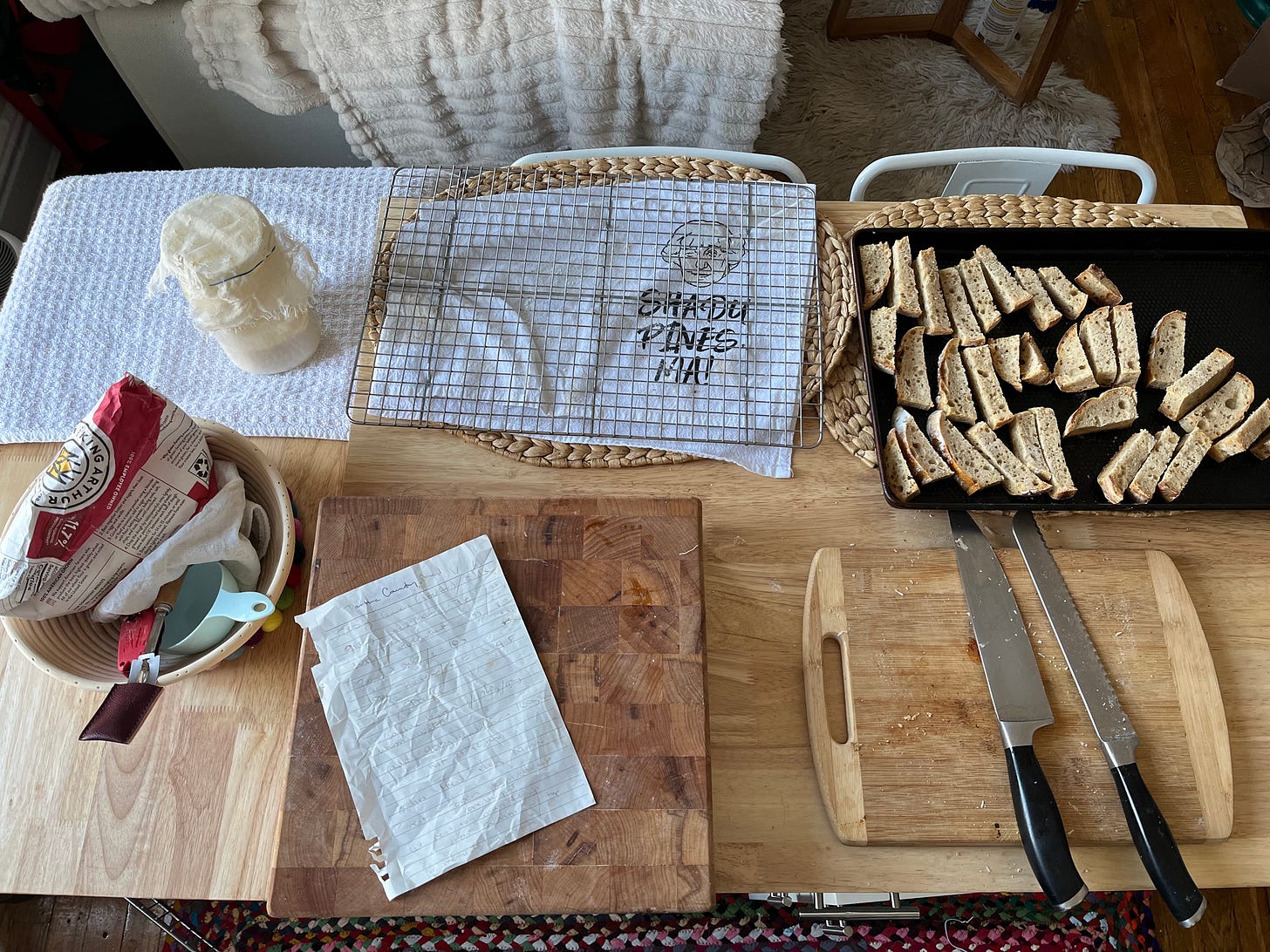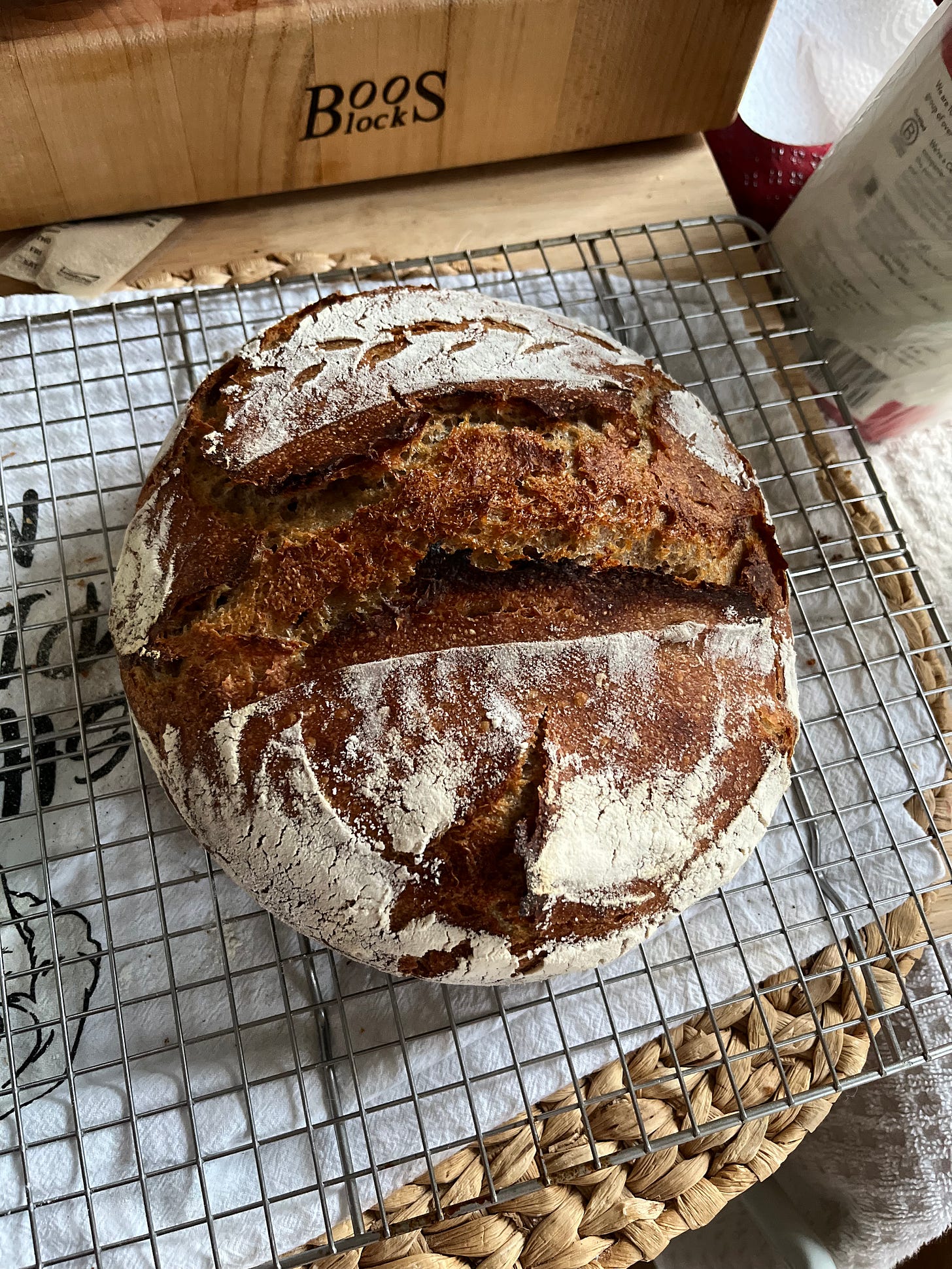HI GUYS HOW’S EVERYONE DOING 2025 IS GOING SO WELL!!!!!!!
I could wax poetic about the current environmental disaster and climate refugee situation in LA, about how climate change is here and how we’re finally feeling the effects of generations of lost indigenous methods of land management, but instead I’ll offer a bread-related distraction…. because we somehow still have to work, feed our families, do laundry and attempt to maintain our sanity even when the world is quite literally burning. And sometimes we just need a break. Or to fully disassociate for awhile.
Praying that all your loved ones, their homes and animals in LA are safe and sound. Praying that the powers that be take this catastrophe- a wildfire in January- seriously, move toward systemic change and make rebuilding efforts smooth, fast and paid for entirely by FEMA and insurance companies.
And now, dinner parties and bread.
Our next *dine well supper club* will take place on Tuesday, January 21st at Umbra Brooklyn, an amazing new jazz club and wine bar in Bushwick. The theme of this five course dinner is American comfort foods and their fascinating roots- from the Italian immigrant fishermen on the 19th century docks of San Francisco, to the upscale hotel restaurants of the roaring 20s, to the Romanian Jews bringing their traditions through Ellis Island to the Lower East Side, to the recently settled Texans fusing native ingredients and practices with their own cooking methods. We’re celebrating winter with warm, soothing foods of the classic American lexicon, and exploring and honoring their immigrant roots.
We are also so excited to offer wine pairings for each course courtesy of the ultra-talented and knowledgeable Umbra staff. Tickets are $125 with wine pairings, and $100 without. We also offer select discounts if the cost is prohibitive- if you want to be there, we want you there, and we want it to be comfortable for you! If you’re in NYC and want to join us (yay!), email me at hello@kaylasimonefowler.com! It’s gonna be a good one and we can’t wait to have dinner with you :)
This winter, I’ve found myself really craving bread. Well… actually, I crave bread every day all year round- if I’m being honest, it accounts for probably like 80% of my diet. But New York has seen some serious cold fronts recently, and there’s nothing like frigid weather and short days to make one yearn for a homemade loaf. The warmth from the oven paired with cozy smell of fresh-baked bread wafting through the house is, in my opinion, one of the great pleasures of life. “Sorry, I can’t come out- I have bread in the oven” is THE perfect excuse to stay in on a cold winter night.
A couple weeks ago, blessed with a burst of motivation and some upcoming free time, I took my trusty yet neglected old starter from its hibernation cave (the back of the fridge). It’s a vestige of the pandemic, and although I revive it from time to time when I’m feeling inspired, it had been more than a year since I’d used it. For those who aren’t familiar with sourdough baking, a starter is simply a lactobacillus yeast culture (wild yeast strains that naturally float through the air) that feeds on flour and warm water, converting the glucose into carbon dioxide through lactic acid fermentation; the CO2 bubbles are what makes the bread rise. When you add some of your starter culture to more flour and water to begin making bread, that portion of starter is known as a leaven.
It wasn’t long before the cycle of feeding, monitoring, discarding, and feeding again became a calming, grounding routine. Regular sourdough baking is actually something of a lifestyle. A starter is a living, breathing thing; it requires attention, observation and daily feedings at somewhat regular intervals, much like a pet. The baker has to become very familiar their starter- the bright and pleasantly pungent smell of a proper fermentation, the appearance and volume of a starter strong enough to leaven bread, the temperature and conditions of their kitchen that help the yeast culture flourish. Already it’s been a comfort for me to care for it, monitor it, and breathe in the familiar pleasant sourness of a well-fed starter- not to mention the unmatched aroma a fresh-baked loaf of bread.
Remember 2020? I’m sure most of us would um- prefer not to, but bear with me as we take a jaunt down memory lane. We all huddled in our homes, anxiously monitoring the news, either going completely out of our minds buying apocalyptic quantities of toilet paper or secretly relishing the brief and unexpected pause in our lives. Some of us even did remote work or tried our best to get our kids to focus on remote school- a Sisyphean task I wouldn’t wish on my worst enemy.
Among the great unifiers of that era- along with Tiger King and untold gallons of hand sanitizer- was bread. For some reason, our collective insanity led us all to fall in love with baking bread. I remember actual yeast shortages- once when a friend in Seattle told me he couldn’t find even one measly package of yeast on any grocery store shelf, I sent him some through the mail; later when the shortage hit New York, he mailed me some back. The hallmark of true friendship.
But by far the biggest subculture of the bread craze was sourdough. It was everywhere- even those with no baking experience jumped on the sourdough bandwagon. We all scoured the internet looking for how-to guides, learning about lacto-fermentation, the perfect crumb, and the magical elasticity of gluten. Some of us likely learned that gluten is a protein, not some terrifying “toxin”, and that the fermentation process makes it easier to digest. Research shows it’s a great option for gluten-sensitive folks (although not celiac folks or those with a wheat allergy- a very important distinction). The sourdough community is still alive and well on both TikTok and Instagram.
I think it’s no wonder the public rediscovered sourdough baking during lockdown. I think folks learned, like I did, that sourdough baking is a practice; it’s something between an art form, a science project and a fine skill that can be continuously developed with trial, error, research and experimentation- a practice you can continue for life. In the absence of social hobbies and gatherings, I think the simple and repetitive routine of sourdough was a balm when our normal routines were suddenly disrupted. The process of baking a loaf from start to finish is very slow, methodical and requires great patience and attention to detail- it can be very meditative.

What folks may or may not have learned in our PhD-level sourdough research projects is that the technique is quite literally as old as civilization itself, and until relatively recently, was the one and only mode of leavening bread. Evidence of sourdough baking has been found in ancient Egyptian tombs, and some sourdough bread excavated in Switzerland was carbon-dated to 3700 BCE. Scholars generally believe that sourdough baking originated in the Fertile Crescent, considered the birthplace of agriculture and civilization. Commercially available yeast wasn’t actually introduced until the 19th century, and the dry yeast packets we recognize from grocery shelves today only date back to World War II. Fleischmann’s Yeast- yup, THAT Fleischmann’s Yeast- was the pioneer of the dried shelf-stable stuff, and they still basically have the market cornered today. Can’t argue with a solid yeast-based business model.
Sourdough practices actually waned somewhat when beer brewing became a regular practice during the Middle Ages. Bakers moved away from true sourdough baking by obtaining and using the leftover yeast that gathers on top of beer to leaven their bread- yeast that produces alcoholic fermentation, instead of lactic acid fermentation, or used some combo of the two. The mid-20th century saw the invention of shelf-stable yeast, making bread baking a quicker, easier cinch for housewives and industrial bakeries alike. The slow, methodical practice of sourdough fell by the wayside.
One of the only places that the tradition continued to thrive was San Francisco. In fact, the legendary Boudin Bakery in San Francisco, which has used the same sourdough starter since its inception in 1849. For whatever reason, the unique strains of wild yeast living in the foggy bayside environment have long been considered to be unmatched, much in the same way that New York pizza and bagels get their famous unparalleled taste from the specific mineral composition in the local water.
Another bread that has remained consistently lacto-fermented through the ages is injera, the staple Ethiopian bread made from an heirloom grain called teff. The Bay Area is in fact blessed with a lot of Ethiopian restaurants, and if you’ve never had Ethiopian food, seriously, run don’t walk. It’s one of my all-time favorite cuisines. It’s harder to find in NYC, but Ghenet near downtown Brooklyn is absolutely incredible.
I am personally super excited about the resurgence of interest in sourdough. Ancient culinary practices like this help bakers connect, consciously or not, with countless generations of home cooks and how they fed their families for eons; baking bread over a hearth or live fire, in a clay or iron pot, in the gigantic ovens of ancient royal palaces. Traditional lacto- fermented foods are delicious- they often taste sort of carbonated and bubbly- and contain more gut-friendly bacterial strains than their industrial counterparts. Even though sourdough is a heated food, which kills some of these microorganisms, it’s no exception.
Sourdough baking is a bit harder in the winter, as starters thrive at a temperature somewhere between 65 and 75 degrees. Here are a few tips for keeping your starter healthy in the colder months:
-most folks recommend keeping your starter in the oven with the light on. You can use an oven-safe thermometer, readily available at specialty home goods stores (and on Amazon), to monitor the temperature.
-A heating pad is a great tool (and in my experience, a slightly better tool- guess my oven is cold as hell) to keep the starter nice and warm. You can also fill a large bowl with a couple inches of fairly hot water and place your starter container in it. You may need to replenish a few times when the water cools down.
-Allow for longer than normal fermentation times if necessary- a cold kitchen means slower fermentation.
-Conventional sourdough wisdom is to feed the starter with warm water, but you can use much warmer water during the winter months to counteract a cold kitchen. Just remember that the yeast culture does die and higher temps, so the water shouldn’t be scalding hot.
-If you’re less of a sourdough baker and more of a sourdough eater, check the ingredients- many breads labeled “sourdough” contain yeast, which is actually a sour mash. A true sourdough will only have three ingredients: flour, water and salt (and occasionally “starter”).
Happy baking (and eating!)! Enjoy delicious sandwiches, pizza bread, French toast and even bread pudding. But honestly, my favorite way to eat a slice of sourdough is lightly toasted with a generous smear of salted butter, possibly dipped in a wintery soup or stew. Just like our ancestors have done since time immemorial :)






